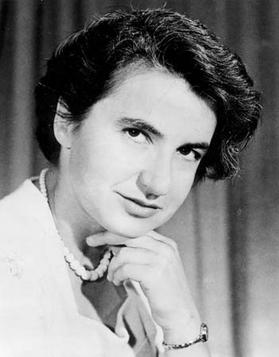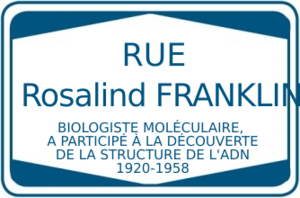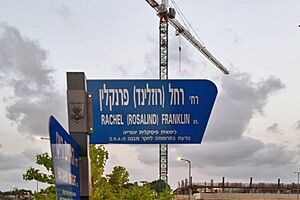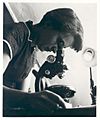Rosalind Franklin facts for kids
Quick facts for kids
Rosalind Elsie Franklin
|
|
|---|---|
 |
|
| Born |
Rosalind Elsie Franklin
25 July 1920 Notting Hill, London, England, UK
|
| Died | 16 April 1958 (aged 37) Chelsea, London, England, UK
|
| Resting place | Willesden United Synagogue Cemetery |
| Nationality | English |
| Education | St Paul's Girls' School |
| Alma mater | University of Cambridge (PhD) |
| Known for |
|
| Scientific career | |
| Fields | |
| Institutions |
|
| Thesis | The physical chemistry of solid organic colloids with special reference to coal (1945) |
| Doctoral students | John Finch and Kenneth Holmes |
Rosalind Franklin (Notting Hill, London, 25 July 1920 – London, 16 April 1958) was a British biophysicist, known for her contributions to the discovery of the structure of DNA. She also worked on coal, studies of RNA, and viruses. She was one of the first people to do X-ray crystallography on DNA. The work of Franklin and the graduate student Raymond Gosling were used by Watson and Crick in their effort to discover the structure of DNA.
Franklin led pioneering work at Birkbeck on the molecular structures of viruses. On the day before she was to unveil the structure of tobacco mosaic virus at an international fair in Brussels, Franklin died of ovarian cancer at the age of 37 in 1958. Her team member Aaron Klug continued her research, winning the Nobel Prize in Chemistry in 1982.
Contents
Early life and family
Franklin was born in 50 Chepstow Villas, Notting Hill, London, into an affluent and influential British Jewish family.
Franklin's father, Ellis Arthur Franklin (1894–1964), was a merchant banker who taught at the city's Working Men's College, and her mother was Muriel Frances Waley (1894–1976). Rosalind was the elder daughter and the second child in the family of five children. David (1919–1986) was the eldest brother while Colin (1923–2020), Roland (1926–2024), and Jenifer (born 1929) were her younger siblings.
Her family was actively involved with the Working Men's College, where her father taught the subjects of electricity, magnetism, and the history of the Great War in the evenings, later becoming the vice principal.
Franklin's parents helped settle Jewish refugees from Europe who had escaped the Nazis, particularly those from the Kindertransport. They took in two Jewish children to their home, and one of them, a nine-year-old Austrian, Evi Eisenstädter, shared Jenifer's room.
Education
From early childhood, Franklin was a bright student. At age six, she joined her brother Roland at Norland Place School, a private day school in West London. At that time, her aunt Mamie (Helen Bentwich), described her to her husband: "Rosalind is alarmingly clever – she spends all her time doing arithmetic for pleasure, and invariably gets her sums right." Franklin also developed an early interest in cricket and hockey. At age nine, she entered a boarding school, Lindores School for Young Ladies in Sussex.
Franklin was 11 when she went to St Paul's Girls' School in Hammersmith, west London, one of the few girls' schools in London that taught physics and chemistry. At St Paul's, she excelled in science, Latin, and sports. Franklin also learned German, and became fluent in French, a language she would later find useful. Franklin topped her classes, and won annual awards. Her only educational weakness was in music, for which the school music director, the composer Gustav Holst, once called upon her mother to enquire whether she might have suffered from hearing problems or tonsillitis. With six distinctions, Franklin passed her matriculation in 1938, winning a scholarship for university, the School Leaving Exhibition of £30 a year for three years, and £5 from her grandfather. Franklin's father asked her to give the scholarship to a deserving refugee student.
University education
Franklin went to Newnham College, Cambridge, in 1938 and studied chemistry within the Natural Sciences Tripos. She passed her finals in 1941, but was only awarded a degree titular, as women were not entitled to degrees (BA Cantab.) from Cambridge at the time. In 1945 Rosalind Franklin received her PhD from Cambridge University.
British Coal Utilisation Research Association
She worked for Ronald Norish between 1941 and 1942. Because of her desire to work during World War II, she worked at the British Coal Utilisation Research Association in Kingston-upon-Thames from August 1942, studying the porosity of coal. Her work helped spark the idea of high-strength carbon fibres and was the basis of her doctoral degree that she earned in 1945.
Laboratoire central des services chimiques de l'État
After the war ended Franklin accepted an offer to work in Paris with Jacques Mering. She learned x-ray diffraction techniques during her three years at the Laboratoire central des services chimiques de l'État. She seemed to have been very happy there and earned an international reputation based on her published research on the structure of coal. In 1950 she sought work in England and in June 1950 she was appointed to a position at King's College London.
King's College London
In January 1951, Franklin started working as a research associate at King's College London in the Medical Research Council's (MRC) Biophysics Unit, directed by John Randall. Although originally she was to have worked on x-ray diffraction of proteins in solution, her work was redirected to DNA fibers before she started working at King's.
Franklin, working with her student Raymond Gosling started to apply her expertise in x-ray diffraction techniques to the structure of DNA. They discovered that there were two forms of DNA: at high humidity (when wet) the DNA fiber became long and thin, when it was dried it became short and fat. These were termed DNA 'B' and 'A' respectively. The work on DNA was subsequently divided, Franklin taking the A form to study and Wilkins the 'B' form. The x-ray diffraction pictures taken by Franklin at this time have been called, by J. D. Bernal, "amongst the most beautiful x-ray photographs of any substance ever taken".
By the end of 1951 it was generally accepted in King's that the B form of DNA was a helix, but Franklin in particular was unconvinced that the A form of DNA was helical in structure. During 1952 Rosalind Franklin and Raymond Gosling worked at applying the Patterson function to the x-ray pictures of DNA they had produced, this was a long and labour-intensive approach but would give an insight into the structure of the molecule.
In February 1953 Francis Crick and James D. Watson of the Cavendish Laboratory in Cambridge University had started to build a model of the B form of DNA using similar data to that available to the team at King's. Model building had been applied successfully in the elucidation of the structure of the alpha helix by Linus Pauling in 1951, but Rosalind Franklin was opposed to building theoretical models, taking the view that building a model was only to be undertaken after the structure was known. Watson and Crick then indirectly obtained a prepublication version of Franklin's DNA X-ray diffraction data (possibly without her knowledge), and a prepublication manuscript by Pauling and Corey, giving them critical insights into the DNA structure.
Francis Crick and James Watson then published their model in Nature on 25 April 1953 in an article describing the double-helical structure of DNA with a small footnote to Franklin's data. Articles by Wilkins and Franklin illuminating their x-ray diffraction data published in the same issue of Nature supported the Crick and Watson model for the B form of DNA. Franklin eventually left King's College London in March 1953 to move to Birkbeck College in a move that had been planned for some time.
Birkbeck College, London

Franklin's work in Birkbeck involved the use of x-ray crystallography to study the structure of the tobacco mosaic virus (TMV) under J. D. Bernal and was funded by the Agricultural Research Council(ARC). In 1954 Franklin began a longstanding and successful collaboration with Aaron Klug. In 1955 Franklin had a paper published in the journal Nature, indicating that TMV virus particles were all of the same length, this was in direct contradiction to the ideas of the eminent virologist Norman Pirie, though her observation ultimately proved correct.
Franklin worked on rod like viruses such as TMV with her Ph.D. student Kenneth Holmes, while Aaron Klug worked on spherical viruses with his student John Finch, Franklin coordinated the work and was in charge. Franklin also had a research assistant, James Watt, subsidised by the National Coal Board and was now the Leader of the "ARC Group" at Birkbeck. By the end of 1955 her team had completed a model of the TMV and were working on viruses affecting several plants, including potato, turnip, tomato and pea. Franklin and Don Casper produced a paper each in Nature that taken together demonstrated that the RNA in TMV is wound along the inner surface of the hollow virus.
Death
In mid-1956, while on a work-related trip to the United States, Franklin first began to suspect a health problem. While in New York, she found difficulty in zipping her skirt; her stomach had bulged. Her case was marked "URGENT". An operation on 4 September of the same year revealed two tumors in her abdomen. After this period and other periods of hospitalisation, Franklin spent time convalescing with various friends and family members.
Franklin chose not to stay with her parents because her mother's uncontrollable grief and crying upset her too much. Even while undergoing cancer treatment, Franklin continued to work, and her group continued to produce results – seven papers in 1956 and six more in 1957.
Franklin returned to work in January 1958 and was also given a promotion to Research Associate in Biophysics on 25 February. She fell ill again on 30 March and died a few weeks later on 16 April 1958 in Chelsea, London, of bronchopneumonia, secondary carcinomatosis, and ovarian cancer. Exposure to X-ray radiation is sometimes considered to be a possible factor in Franklin's illness. Other members of her family have died of cancer. She was interred on 17 April 1958 in the family plot at Willesden United Synagogue Cemetery at Beaconsfield Road in London Borough of Brent.
Personal life
Franklin was best described as an agnostic. Her lack of religious faith apparently did not stem from anyone's influence, rather from her own line of thinking. She developed her scepticism as a young child.
However, Franklin did not abandon Jewish traditions. As the only Jewish student at Lindores School, she had Hebrew lessons on her own while her friends went to church. She joined the Jewish Society while in her first term at Cambridge, out of respect of her grandfather's request. Franklin confided to her sister that she was "always consciously a Jew".
Franklin loved travelling abroad, particularly trekking.
Franklin always kept her deepest personal feelings to herself. She was never married and had no children.
Awards and honours
Posthumous recognition
- 1982, Iota Sigma Pi designated Franklin a National Honorary Member.
- 1984, St Paul's Girls School established the Rosalind Franklin Technology Centre.

- 1992, English Heritage placed a blue plaque commemorating Franklin on the building in Drayton Gardens, London, where she lived until her death.
- 1993, King's College London renamed the Orchard Residence at its Hampstead Campus as Rosalind Franklin Hall.
- 1993, King's College London placed a blue plaque on its outside wall bearing the inscription: "R. E. Franklin, R. G. Gosling, A. R. Stokes, M. H. F. Wilkins, H. R. Wilson – King's College London – DNA – X-ray diffraction studies – 1953."
- 1995, Newnham College, Cambridge opened a graduate residence named Rosalind Franklin Building, and put a bust of her in its garden.
- 1997, Birkbeck, University of London School of Crystallography opened the Rosalind Franklin Laboratory.
- 1997, a newly discovered asteroid was named 9241 Rosfranklin.
- 1998, National Portrait Gallery in London added Rosalind Franklin's portrait next to those of Francis Crick, James Watson and Maurice Wilkins.
- 1999, the Institute of Physics at Portland Place, London, renamed its theatre as Franklin Lecture Theatre.
- 2000, King's College London opened the Franklin–Wilkins Building in honour of Franklin's and Wilkins's work at the college.
- 2000, We the Curious (formally @Bristol) has a Rosalind Franklin Room.
- 2001, the American National Cancer Institute established the Rosalind E. Franklin Award for women in cancer research.
- 2002, the University of Groningen, supported by the European Union, launched the Rosalind Franklin Fellowship to encourage women researchers to become full university professors.
- 2003, the Royal Society established the Rosalind Franklin Award (officially the Royal Society Rosalind Franklin Award and Lecture) for an outstanding contribution to any area of natural science, engineering or technology. The award consists of a silver-coated medal and a grant of £30,000.
- 2003, the Royal Society of Chemistry declared King's College London as "National Historic Chemical Landmark" and placed a plaque on the wall near the entrance of the building, with the inscription: "Near this site Rosalind Franklin, Maurice Wilkins, Raymond Gosling, Alexander Stokes and Herbert Wilson performed experiments that led to the discovery of the structure of DNA. This work revolutionised our understanding of the chemistry behind life itself."
- 2004, Finch University of Health Sciences/The Chicago Medical School, located in North Chicago, Illinois, USA changed its name to the Rosalind Franklin University of Medicine and Science. It also adopted a new motto "Life in Discovery", and Photo 51 as its logo.
- 2004, the Gruber Foundation started the Rosalind Franklin Young Investigator Award for two female geneticists from all over the world. It carries an annual fund of $25,000, each award is for three years, and selection is made by a joint committee appointed by the Genetics Society of America and the American Society of Human Genetics.
- 2004, the Advanced Photon Source (APS) and the APS Users Organization (APSUO) started the APSUO Rosalind Franklin Young Investigator Award for young scientists who made contributions through the APS.
- 2005, the DNA sculpture (donated by James Watson) outside Clare College, Cambridge's Memorial Court incorporates the words "The double helix model was supported by the work of Rosalind Franklin and Maurice Wilkins."
- 2005, the Ovarian Cancer Research Alliance, based in Florida, US, established an annual award the Rosalind Franklin Prize for Excellence in Ovarian Cancer Research.
- 2006, the Rosalind Franklin Society was established in New York by Mary Ann Liebert. The Society aims to recognise, foster, and advance the important contributions of women in the life sciences and affiliated disciplines.
- 2008, Columbia University awarded an honorary Louisa Gross Horwitz Prize to Franklin, "for her seminal contributions to the discovery of the structure of DNA".
- 2008, the Institute of Physics established a biennial award the Rosalind Franklin Medal and Prize.
- 2012, the bioinformatics education software platform Rosalind was named in honour of Franklin.
- 2012, The Rosalind Franklin Building was opened at Nottingham Trent University.
- 2013, Google honoured Rosalind Franklin with a doodle, showing her gazing at a double helix structure of DNA with an X-ray of Photo 51 beyond it.
- 2013, a plaque was placed on the wall of The Eagle pub in Cambridge commemorating Franklin's contribution to the discovery of the structure of DNA, on the sixtieth anniversary of Crick and Watson's announcement in the pub.
- 2014, the Rosalind Franklin Award for Leadership in Industrial Biotechnology was established by Biotechnology Industry Organization (Biotechnology Innovation Organization since 2016) in collaboration with the Rosalind Franklin Society, for an outstanding woman in the field of industrial biotechnology and bioprocessing.
- 2014, the Rosalind Franklin University of Medicine and Science unveiled a bronze statue of Franklin, created by Julie Rotblatt-Amrany, near its front entrance.
- 2014, the Rosalind Franklin STEM Elementary was opened in Pasco, Washington, the first science, technology, engineering, and math (STEM) elementary school in the district.
- 2014, the University of Wolverhampton opened its new laboratory building named the Rosalind Franklin Science Building.
- 2015, Newnham College Boat Club, Cambridge, launched a new racing VIII, naming it the Rosalind Franklin.
- 2015, the Rosalind Franklin Appathon was launched by University College London as a national app competition for women in STEMM (science, technology, engineering, maths and medicine).
- 2015, a high performance computing and cloud facility in London was named Rosalind.
- 2016, the British Humanist Association added the Rosalind Franklin Lecture to its annual lecture series, aimed to explore and celebrate the contribution of women towards the promotion and advancement of humanism.
- 2016, the Rosalind Franklin Prize and Tech Day was held on 23 February in London, organised by University College London, i-sense, UCL Enterprise, the London Centre for Nanotechnology and the UCL Athena SWAN Charter.

- 2017, Rue Rosalind Franklin made.
- 2017, DSM opened the Rosalind Franklin Biotechnology Center in Delft, the Netherlands.
- 2017, Historic England gave a heritage listing, at Grade II, to Franklin's tomb at Willesden Jewish Cemetery on the grounds of it being of "special architectural or historic interest". Historic England said that "the tomb commemorates the life and achievements of Rosalind Franklin, a scientist of exceptional distinction, whose pioneering work helped lay the foundations of molecular biology; Franklin's X-ray observation of DNA contributed to the discovery of its helical structure."
- 2018, the Rosalind Franklin Institute, an autonomous medical research centre under the joint venture of 10 universities and funded by the United Kingdom Research and Innovation, was launched at the Harwell Science and Innovation Campus on 6 June, and was officially opened on 29 September 2021.
- 2019, the European Space Agency (ESA) named its ExoMars rover Rosalind Franklin.
- 2019, the University of Portsmouth announced that it changed the name James Watson Halls to Rosalind Franklin Halls from 2 September.
- 2020, Franklin was selected for the Time 100 Women of the Year, for 1953.
- 2020, the UK Royal Mint released a 50-pence coin in honour of the hundredth anniversary of Franklin's birth on 25 July. It features a stylised version of Photo 51.
- 2020, South Norfolk Council renamed a road on the Norwich Research Park in her honour in July 2020. The road is home to the Quadram Institute and the University of East Anglia's Bob Champion Research and Education Building.
- 2020, Trinity College Dublin announced that its library had previously held forty busts, all of whom were of men, was commissioning four new busts of women one of whom would be Franklin.
- 2020, Aston Medical School instituted an annual competition for medical students named the Rosalind Franklin Essay Prize, funded by its alumni and Rosalind's nephew, Daniel Franklin, executive and diplomatic editor of The Economist.
- 2021, a bronze tondo of Rosalind Franklin was placed on Hampstead Manor and unveiled on 15 March.
- On 30 June 2021, a satellite named after her (ÑuSat 19 or "Rosalind", COSPAR 2021-059AC) was launched into space.
- 2021, the Rosalind Franklin laboratory was opened in the Royal Leamington Spa, Warwickshire, on 13 July as the largest laboratory for COVID-19 testing under the UK Health Security Agency and National Health Service Test and Trace network, and supported by the University of Warwick.
- 2022, the new bacterial genus, Franklinella, in the family Comamonadaceae, was described in her honour.

- As of 2024, Rachel (Rosalind) Franklin st. was named for her.
Images for kids
See also
 In Spanish: Rosalind Franklin para niños
In Spanish: Rosalind Franklin para niños




